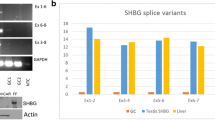Abstract
In order to determine the regulation of the oviduct progesterone receptor inChrysemys picta, radioligand binding studies were performed to determine changes in the high and lower affinity binding sites during the seasonal cycle. Lower affinity sites were present in both cytosolic and nuclear fractions during the cycle and peaked during the peri-ovulatory/early luteal periods. The high affinity sites, present exclusively in the nuclear fraction, increased following the preovulatory peak in plasma estradiol, remained elevated during the early luteal phase following the post-ovulatory peak in progesterone, and declined to non-detectable levels just before egg-laying. DNA-cellulose affinity chromatography showed that both high and low affinity binding sites were integral to both progesterone receptor B and A isoforms. Western blot analysis confirmed the binding studies and showed that PR-B (115 kDa) was present in greatest amounts during the peri-ovulatory and luteal periods, whereas PR-A (88 kDa) increased during those periods and was present following egg-laying. Immunocytochemical analysis revealed increased progesterone receptor immunostaining from the winter to the peri-ovulatory period in the three major zones (luminal epithelium, submucosal glands and the myometrium) following the preovulatory peak in estradiol, a decrease in all three zones, especially the myometrium, in the late luteal period following the post-ovulatory peak in progesterone, and an increase again during fall recrudescence. Competition studies demonstrated that progesterone was the most effective competitor followed by pregnenolone, R5020 and deoxycorticosterone. RU 486 does not bind to the high affinity site, but binds quite well to the lower affinity site. This study suggests that progesterone receptor isoforms in the turtle oviduct may be under the regulation of changing estrogen/progesterone ratios during the cycle.
Similar content being viewed by others
References
Aitken, R.N.C. & Solomon, S.E. (1976).J. Exp. Mar. Biol. Ecol.,21, 75–90.
Alberts, B.M. & Herrick, G. (1970).Methods of Enzymology, vol. XXI. Grossman, S. & Moldare, K. (eds), Academic Press: New York, pp. 198–217.
Baulieu, E.E. (1989).Science,245, 1351–1357.
Botte, V., Segal, S.J. & Koide, S.S., (1974).Gen. Comp. Endocrinol.,23, 357–359.
Callard, I.P. & Hirsch, M. (1976).J. Endocrinol.,68, 147–152.
Callard, I.P., Lance, V., Salhanick, A.R. & Barad, D. (1978).Gen. Comp. Endocrinol.,35, 245–257.
Callard, I.P., Fileti, L.A., Perez, L.E., Sorbera, L.A., Giannoukos, G., Klosterman, L.L., Tsang, P. & McCracken, J.A. (1992).Am. Zool.,32, 264–275.
Callard, I.P., Giannoukos, G., Charnock-Jones, D.S., Benson, S. & Paolucci, M. (1994). Perspectives in Comparative Endocrinology,National Research Council Journal (Canada), pp. 325–332.
Chen, T.J. & Leavitt, W.W. (1979).Endocrinology,104, 1588–1597.
Coty, W.A., Schrader, W.T. & O'Malley, B.W. (1979).J. Steroid Biochem.,10, 1–12.
Cuevas, M.E. & Callard, G.V. (1992).Endocrinology,130, 2173–2182.
Frudman, J., Mimmesgern, E., Ohtsuka, K. & Hartl, F.U. (1994).Nature,370, 111–117.
Fuller, P.J., Lim-Tio, S., Keightly, C. & Fletcher, T.P. (1994).J. Cell Biochem., Suppl. 18B, Abst. no. K112, p. 243.
Giersberg, H. (1923).Z. Wiss. Zool.,120, 1–97 (cited in Parker, 1931).
Gray, G.O. & Leavitt, W.W. (1987).J. Steroid Biochem.,28, 493–497.
Harless, M. & Morlock, H. (1979).Turtles: Perspectives and Research, John Wiley and Sons, Inc.: New York.
Ho, S.M. & Callard, I.P. (1984).Endocrinology,114, 70–79.
Joensuu, T.K., Ylikomi, T.J., Toft, D.O., Keinanen, R.A., Kulomma, M.S. & Tuohimaa, P.J. (1990).Endocrinology,126, 1143–1155.
Kleis-San Francisco, S.M. & Callard, I.P. (1986).Gen. Comp. Endocrinol.,63, 220–229.
Kohler, P.O., Grimley, P.M. & O'Malley, B.W. (1968).Science,160, 86–87.
Laemmli, U.K. (1970).Nature,227, 680–685.
Li, W., Boomsma, R.A. & Verhage, H.G. (1992).Biol. Reprod.,47, 1073–1081.
Lowry, O.H., Roseborough, N.J., Farr, A.L. & Randall, R.J. (1951).J. Biol. Chem.,193, 265–275.
Maggi, A., Schrader, W.T. & O'Malley, B.W. (1984).J. Biol. Chem.,259, 10956–10966.
Mak, P., Ho, S.M. & Callard, I.P. (1983).Gen. Comp. Endocrinol.,53, 182–189.
Mead, R.A., Eroschenko, V.P. & Highfill, D.R. (1981).Gen. Comp. Endocrinol.,45, 345–354.
Mester, J. & Baulieu, E.E. (1984).Trends Biochem. Sci.,9, 56–59.
Motz, V.A. & Callard, I.P. (1988).Gen. Comp. Endocrinol.,72, 453–460.
Motz, V.A. & Callard, I.P. (1991).J. Morphology,207, 59–71.
Moudgil, V.K., Lombardo, G., Hurd, C., Eliezer, N. & Agarwal, M.K. (1986).Biochim. Biophys. Acta,889, 192–199.
Murthy, L.R., Johnson, M.P., Rowley, D.R., Young, C.Y., Scardino, P.T. & Tindall, D.J. (1986).Prostate,8, 241–253.
Oka, T. & Schimke, R.T. (1969a).J. Cell. Biol.,41, 816–831.
Oka, T. & Schimke, R.T. (1969b).J. Cell. Biol.,43, 123–137.
Okulicz, W.C., Balsamo, M. & Task, J. (1993).Biol. Reprod.,49, 24–32.
Ortiz, E. & Morales, M.H. (1974).Physiol. Zool.,47, 207–217.
Paolucci, M. & Di Fiori, M.M. (1994).J. Exp. Zool.,269, 432–441.
Reese, J.C. & Callard, I.P. (1989).J. Steroid Biochem.,33, 297–310.
Riley, D., Reese, J.C. & Callard, I.P. (1988).Endocrinology,123, 1195–1201.
Rothchild, I. (1981).Rec. Prog. Horm. Res.,37, 183–298.
Salhanick, A.R., Vito, C.C., Fox, T.O. & Callard, I.P. (1979).Endocrinologh,105, 1388–1394.
Sarup, J.C., Rao, K.V.S., Williams, R.E. & Fox, C.F. (1988).J. Biol. Chem.,263, 5624–5633.
Selcer, K.W. & Leavitt, W.W. (1991).Gen. Comp. Endocrinol. 83, 316–323.
Sullivan, W.P., Smith, D.F., Beito, T.G., Kreo, C.J. & Toft, D.O. (1988).J. Cell. Biochem.,36, 103–119.
Venkatesh, B., Tan, C.H. & Lam, T.T. (1989).Gen. Comp. Endocrinol.,76, 398–407.
Author information
Authors and Affiliations
Rights and permissions
About this article
Cite this article
Giannoukos, G., Coho, D.W. & Callard, I.P. Turtle oviduct progesterone receptor: radioligand and immunocytochemical studies of changes during the seasonal cycle. Endocr 3, 429–437 (1995). https://doi.org/10.1007/BF02935649
Received:
Accepted:
Issue Date:
DOI: https://doi.org/10.1007/BF02935649




